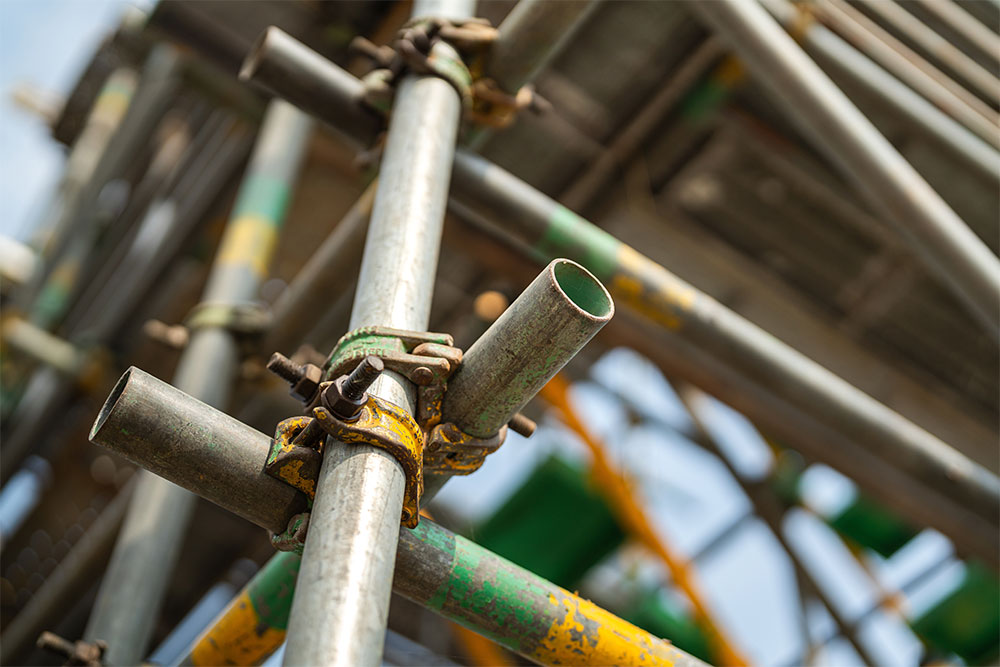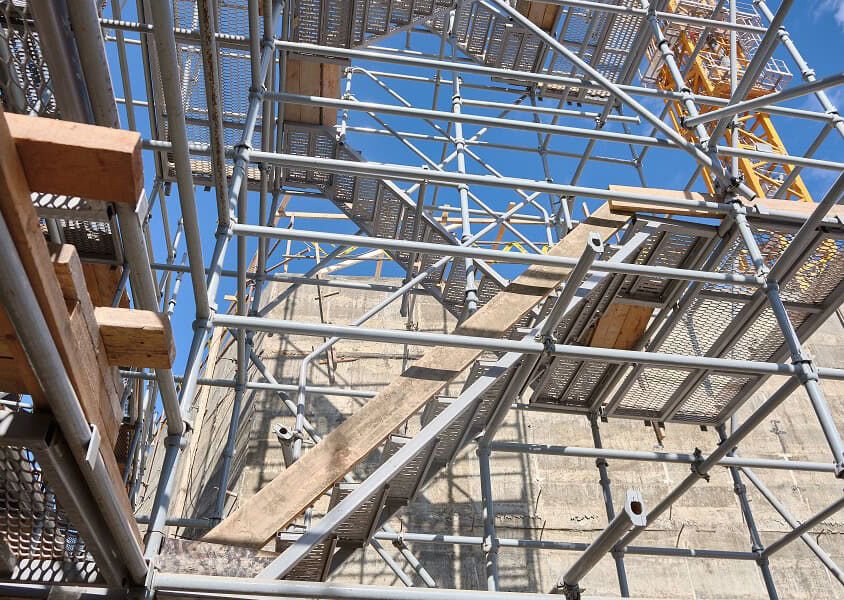Expert Scaffolder Surrey Offering Customized Solutions for Your Needs
Expert Scaffolder Surrey Offering Customized Solutions for Your Needs
Blog Article
A Comprehensive Guide to the Vital Features of Scaffolding in Modern Building And Construction
The landscape of modern construction significantly counts on reliable scaffolding systems that focus on security, performance, and innovation. As projects grow in intricacy, comprehending the necessary features of scaffolding becomes essential for guaranteeing worker security and optimizing task timelines. This guide explores different kinds of scaffolding, highlights key safety features, and examines product developments that add to efficiency and sustainability. The ramifications of these elements expand far past plain building methods, triggering a closer look at how they influence total job success and employee well-being.
Types of Scaffolding
Although scaffolding systems can vary widely in design and application, they generally come under several distinctive groups that satisfy different building needs - Scaffolding. One of the most typical types consist of sustained scaffolding, put on hold scaffolding, and rolling scaffolding
Sustained scaffolding includes systems sustained by a framework of poles, which supply a stable and elevated functioning surface. This kind is normally made use of for jobs that require substantial elevation, such as bricklaying or external painting.
Suspended scaffolding, on the other hand, is used for jobs needing accessibility to high altitudes, such as cleansing or repairing structure facades. This system hangs from another framework or a roof, enabling workers to lower or elevate the platform as required.
Rolling scaffolding features wheels that enable easy wheelchair throughout a job website. It is especially beneficial for jobs that need constant relocation, such as interior operate in huge rooms.
Each kind of scaffolding is developed with details applications in mind, guaranteeing that construction jobs can be lugged out successfully and effectively. Understanding these classifications is vital for picking the suitable scaffolding system to fulfill both task demands and site problems.
Trick Safety Functions
Safety is critical in scaffolding systems, as the potential threats related to functioning at elevations can result in severe mishaps otherwise appropriately managed. Secret security features are crucial to make certain the wellness of workers and the stability of the building and construction site.
Primarily, guardrails are vital. These barriers provide a physical secure against falls, substantially lowering the threat of major injuries. In addition, toe boards are commonly made use of to stop devices and products from dropping off the scaffold, safeguarding workers below.
An additional crucial part is making use of non-slip surfaces on platforms. This feature enhances grasp, specifically in negative weather, consequently reducing the chance of falls and slips. Accessibility ladders must be safely placed to assist in secure entrance and leave from the scaffold.
Routine assessments and upkeep of scaffolding systems are additionally essential. These evaluations ensure that all components remain in excellent condition and functioning appropriately, resolving any kind of wear or damage quickly.
Lastly, proper training for all workers associated with scaffolding operations is necessary to ensure that they understand safety and security methods and can identify potential hazards. Scaffolding. Collectively, these attributes produce a more secure working environment and substantially alleviate risks related to scaffolding
Material Innovations
Advancements in material science have actually considerably influenced the scaffolding sector, boosting both safety and security and performance in modern construction. The intro of high-strength steel and light weight aluminum alloys has actually transformed standard scaffolding systems. These products are not only lighter, making them easier to set up and move, however also offer remarkable load-bearing capabilities. This results in scaffolding frameworks that can sustain higher weights while minimizing the danger of collapse.
Additionally, cutting-edge composite materials, such as fiberglass-reinforced plastics, have actually become feasible alternatives. These materials are resistant to rust and environmental destruction, thus prolonging the life-span of scaffolding systems, especially in rough weather condition problems. Making use of such materials adds to lower upkeep prices and makes certain consistent performance with time.


Design Factors To Consider
Thinking about the intricacies of modern building tasks, reliable scaffolding layout scaffolding fittings is vital to guaranteeing both performance and security. Layout considerations have to incorporate various aspects, including load capacity, height, and the details requirements of the construction website. Each task offers special difficulties, necessitating an adaptable technique to scaffolding systems that can adjust to differing problems.
Architectural stability is crucial; for that reason, designers must compute the tons that the scaffolding will certainly sustain, including employees, materials, and devices. The choice of products plays a critical duty in ensuring the scaffolding can endure these loads while continuing to be resilient and light-weight. Additionally, the layout must permit simple gain access to and egress, facilitating the smooth movement of personnel and materials.
Security features, such as guardrails and non-slip surfaces, ought to be included More hints to lessen risks of accidents. The design should consider the surrounding setting, consisting of nearby frameworks and prospective risks. By resolving these layout considerations, building companies can enhance the effectiveness of scaffolding systems and advertise a much safer working environment, ultimately contributing to the general success of the project.
Upkeep and Assessments
The efficiency of scaffolding systems prolongs beyond preliminary layout and implementation; recurring upkeep and routine inspections are vital to ensuring their continued efficiency and safety and security throughout the period of a task. Regular inspections should be carried out by certified personnel to determine any kind of indications of wear, damage, or instability that could compromise the integrity of the scaffolding.
Upkeep protocols must consist of regular checks of architectural components, such as planks, fittings, and structures, making sure that all components continue to be totally free and protected from deterioration or other degeneration. In addition, the performance of safety attributes, such as guardrails and toe boards, should be examined to make certain conformity with safety and security regulations.
Paperwork of all evaluations and maintenance activities is vital for accountability and regulative compliance. A systematic approach to record-keeping not only help in tracking the problem of the scaffolding but also gives essential evidence in the occasion of an event.
Ultimately, establishing a thorough maintenance and examination routine will significantly lower the danger of crashes and enhance the overall safety and security of the building website. By focusing on these techniques, construction managers can secure workers and promote the job's integrity.

Conclusion
In final thought, the important features of scaffolding in contemporary construction incorporate a variety of vital elements, including diverse types, vital safety devices, material innovations, and thoughtful style considerations. Highlighting security via guardrails and non-slip surfaces, along with innovations in materials like high-strength steel, boosts both efficiency and sustainability. Furthermore, normal upkeep and evaluations are important for making certain structural honesty and security on building and construction websites, ultimately assisting in reliable job implementation and promoting the health of workers.
The landscape of modern building and construction increasingly counts on effective scaffolding systems that prioritize safety and security, efficiency, and innovation.Advancements in product scientific research have actually dramatically affected the scaffolding market, boosting both safety and security and efficiency in contemporary building. Overall, these material advancements not just enhance the performance and safety of scaffolding systems but likewise line up with the market's push towards sustainability, as several modern-day materials are designed to be more environmentally friendly.
Thinking about the intricacies of modern-day construction jobs, effective scaffolding style is extremely important to guaranteeing both performance and safety and security.In over at this website conclusion, the vital attributes of scaffolding in modern construction include an array of vital aspects, including varied kinds, crucial safety devices, product technologies, and thoughtful style considerations.
Report this page